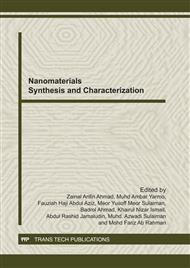p.191
p.196
p.202
p.206
p.211
p.217
p.222
p.228
p.232
Catalytic Activity and Physical Properties of Nanoparticles Metal Supported on Bentonite for Hydrogenolysis of Glycerol
Abstract:
Catalysts prepared from a variety of noble metal (Os, Ru, Pd and Au) supported on bentonite using impregnation method were studied and it found these series catalyst system gave different activity and selectivity. Among these catalysts, Os/bentonite and Ru/bentonite catalyst showed high activity in glycerol hydrogenolysis reaction at 150°C, 2.0 MPa initial hydrogen pressure for 7 hours. TEM analysis revealed that these nanometal particles catalyst have different in size and result showed that Os and Ru which have smaller average size in range 1-3 nm gave high activity which are 54.1% and 61.2% respectively. In contrast, less activity was obtained when using Pd/bentonite (29.0%) and Au/bentonite (27.8%) catalyst and TEM result showed that Pd and Au nanoparticles have large average particles size (8-10) nm. NH3-TPD analysis revealed that Ru/bentonite and Os/bentonite catalyst gave high total acidity and this behaviour contribute to high activity of the catalyst. This study revealed that size of nanoparticles and catalyst acidity play an important role in the activity and selectivity in glycerol hydrogenolysis reaction. These catalysts were also characterized by BET, XRD and XPS in order to get some physicochemical properties of the catalyst.
Info:
Periodical:
Pages:
211-216
Citation:
Online since:
October 2011
Keywords:
Price:
Сopyright:
© 2012 Trans Tech Publications Ltd. All Rights Reserved
Share:
Citation:


